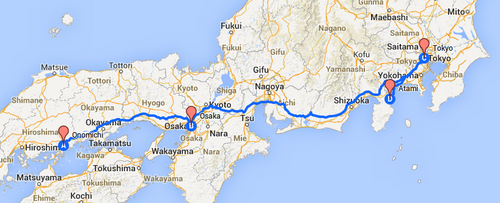তোকিও মোনোগাতারি
| Tokyo Story | |
|---|---|

| |
| ঘরানা | নাট্য |
| পরিচালনা | ইয়াসুজিরো ওজু |
| প্রযোজনা | Takeshi Yamamoto |
| চিত্রনাট্য | Kôgo Noda, Yasujirô Ozu |
| অভিনয় | Chishû Ryû, Chieko Higashiyama, Setsuko Hara, Haruko Sugimura, Sô Yamamura |
| সঙ্গীত | Takanobu Saito |
| চিত্রগ্রহণ | Yûharu Atsuta |
| সম্পাদনা | Yoshiyasu Hamamura |
| স্টুডিও | Shôchiku Eiga |
| মুক্তি | ১৯৫৩ |
| দৈর্ঘ্য | ১৩৬ মিনিট |
| ভাষা | Japanese, English |
| রঙ | Black and White |
| শুটিংস্থল | Atami, Shizuoka, Japan |
| রেটিংসমগ্র | |
| IMDb | ৮.২/১০ (১৭,৯০৪) |
| Ebert | ৪.০/৪.০ |
| আমার | ১০/১০ |
পর্যালোচনা
চরিত্রসমূহ
- Chishû Ryû — Shukishi Hirayama
- Chieko Higashiyama — Tomi Hirayama
- Setsuko Hara — Noriko Hirayama
- Haruko Sugimura — Shige Kaneko
- Sô Yamamura — Koichi Hirayama
- Kuniko Miyake — Fumiko Hirayama - his wife
- Kyôko Kagawa — Kyôko Hirayama
- Eijirô Tôno — Sanpei Numata
- Nobuo Nakamura — Kurazo Kaneko
- Shirô Osaka — Keizo Hirayama
- Hisao Toake — Osamu Hattori
- Teruko Nagaoka — Yone Hattori
- Mutsuko Sakura — Oden-ya no onna
- Toyo Takahashi — Rinka no saikun (as Toyoko Takahashi)
- Tôru Abe — Tetsudou-shokuin
মন্তব্য
|
We miss the visual cues and shorthand used by Western directors to lead us by the nose. With Ozu, it's as if the characters are living their lives unaware that a movie is being shot. We escape into truisms, small talk and distractions. Given the opportunity at a family gathering to share our hopes and disappointments, we talk about the weather and watch TV. Ozu uses "pillow shots" like the pillow words in Japanese poetry, separating his scenes with brief, evocative images from everyday life. He likes trains, clouds, smoke, clothes hanging on a line, empty streets, small architectural details, banners blowing in the wind (he painted most of the banners in his movies himself). If there is movement in an Ozu film, it comes from nature or people, not from the camera. the old father in "Tokyo Story" often smiles and says "yes," and what he means is sometimes yes, sometimes no, sometimes deep regret, sometimes a decision to keep his thoughts to himself. There is an extraordinary scene soon after the old parents arrive. "These are your grandparents," Fumiko tells her oldest son, Minoru. And then to her mother-in-law: "Minoru is in middle school now." So this is the first time he has met them, yet he escapes quickly to his room. At the spa, we see young people dancing and playing cards, and then, in one of those perfect Ozu shots, two pairs of shoes placed neatly side by side outside the old couple's door. |
|
The reason for the low camera position is that it eliminates depth and makes a two-dimensional space. |
|
When Richie’s Ozu was published, two years later, critics came to realize that this quiet filmmaker was one of cinema’s finest artists. In the 1992 and 2002 Sight and Sound international critics’ polls, Tokyo Story was ranked as one of the ten greatest films ever made. After leaving their youngest child, Kyoko, behind, the Hirayamas are shown visiting their children in descending birth order. First they stay with Koichi and his family, then with Shige and hers, then with Noriko (who married their third-born child), and finally with young Keizo in Osaka. Offscreen, they have visited Keizo first en route to Tokyo, but Ozu and his scenarist, Yoshikata Yoda, portray only their stopover during their return trip—partly to allow us to form expectations about how hospitable their youngest son will be, but also to respect the family-tree structure. Who can say which woman is the more virtuous? Jane Austen, Anton Chekhov—these are the artists who come to mind when we confront a story told through such tactful revelations of temperament and states of mind. Yet there is nothing mild about Ozu’s tact; it acquires a stringent poignancy. “What a treat,” reflects Tomi, “to sleep in my dead son’s bed.” Tokyo Story also exemplifies Ozu’s unique style—low camera height, 180-degree cuts, virtually no camera movements, and shots linked through overlapping bits of space. In dialogue scenes Ozu refuses to cut away from a speaking character; it’s as if every person has the right to be heard in full. Yet the momentous revelations are tempered by the poetic resonance of everyday acts and objects. Shukichi greets a beautiful sunrise—signaling another day of brisk fanning and plucking at one’s kimono. An ordinary wristwatch links mother, daughter, and daughter-in-law in a lineage of hard-earned feminine wisdom. And the roar of a train dies down, leaving only the throbbing of a boat in the bay. |

